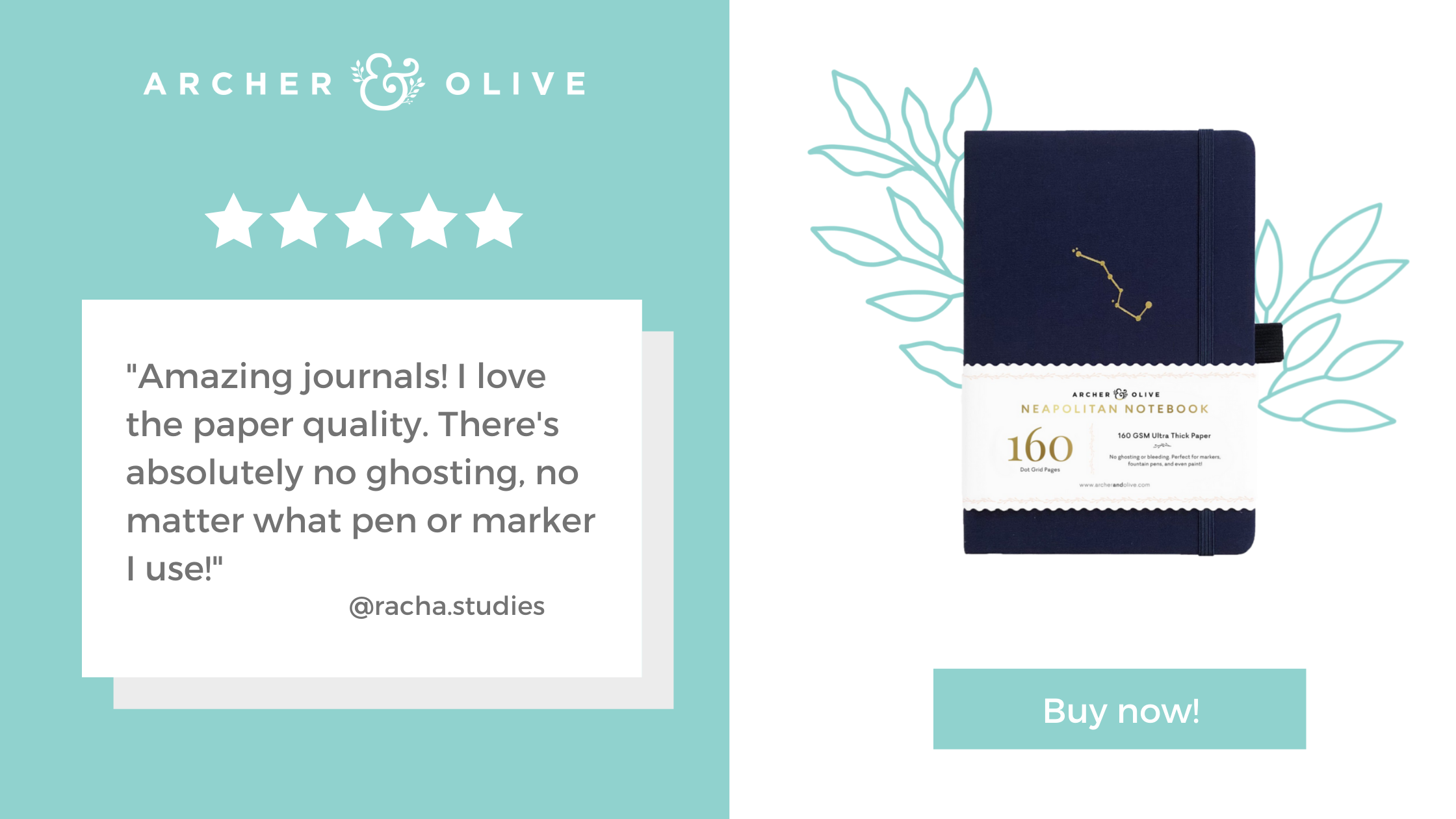What Are Dutch Doors? And Tips To Creating Them In Your Own Bullet Journal
Hey again! It’s Hayley here (@hayleyremdeart on Instagram), and today I wanted to talk about a big trend in bullet journalling - dutch doors. If you're curious to what these are, or simply want so inspiration - keep on reading!
Supplies For Making Dutch Doors:
- Archer and Olive Journal – The lovely and thick mean the Dutch Doors are stronger than those in journals with thinner pages.
- Craft Knife and Cutting Board (Or Scissors) – See below why I recommend using a craft knife over scissors.
- Pencil – It is really important for these spreads to carefully plan out your ideas so you can make sure it has everything you need.
- Fineliners – My favourites are the Unipin fineliners as they’re waterproof, affordable and have a strong nib.
- Decorative Touch (optional) – This could be anything from washi to watercolour, or of course, nothing! I usually like to add a personal touch to my spreads so they’re more fun to use and look at.
But First Up, What Are Dutch Doors?
A big trend in bullet journaling the past few years has been something called ‘Dutch Door’ spreads. In short, these are spreads where some of the pages have been cut down, giving the illusion of literal Dutch Doors (a door that is cut in half horizontally, meaning the top half can open independently of the bottom half). Here’s a picture of one to give you a visual idea:

I’m not sure who started the trend (and I did really try to find them but I couldn’t, so if you know the originator of this trend please let me know!), but these spreads have been really popular. They’re extremely fun to make, and as well as making a spread look really unique and aesthetically pleasing, they can also be really useful! Depending on how you make them, they can give the illusion of more space on one spread, as the cut down pages are ‘enclosed’ in the outside pages. For example, in this spread the cut pages are decent sized dailies, but they’re perceived as one weekly spread:

Dutch doors have completely evolved from one horizontal cut, and now any spreads that feature a cut page are usually referred to as Dutch Doors. There are some amazingly clever and unique spreads influenced by this trend, and later in this blog I’ll show you some of them! But first, lets talk about how they’re made.
How To Create Dutch Doors
Dutch Door spreads are extremely pretty and functional, but maybe you’re seeing all these gorgeous spreads with cut pages, and thinking: “surely this will ruin the binding” or “what if I make a mistake and ruin my journal?” I thought the exact same thing when I first saw them. And I’ll admit - that first cut I made in my journal was absolutely terrifying. But now I’m hooked! Whilst there are many ways to cut your journal to make Dutch Doors, these are the supplies I recommend, and also some important tips to keep in mind when you’re cutting near the binding.
Tip One: Use A Craft Knife
For cutting the pages, I really recommend in investing in a craft knife and cutting board. It is much more precise, so it is a lot easier cut pages close to the binding rather than through it (it is almost impossible to do this with scissors without also ripping the page). By making a clean cut, you can leave a small margin of paper so the page is still attached at the binding, and you are ensuring the page doesn’t rip past the binding and through to the other side of the page. When this happens, the other page becomes loose, and can even fall out. This may be ok if the other page is later in the journal and hasn’t been used yet, but you don’t want to lose a page that has been written on!

Tip Two: Don’t Cut Too Many Pages In A Row
There is not hard fast rule for how many pages you can cut, but I find the Archer and Olive Journal can manage at least 4 pages being cut at the binding, but I haven’t pushed it further than that. For other journals this may be less, but the key is when you’re trying it out, be flexible with your plans so you can cut less pages if needed.

Tip Three: Space Them Out
When you’re cutting over 4/5 pages in a row, try and have at least one or two spreads in between the Dutch Door spreads to give the binding a little break. If you keep using them, the binding remaining will have more and more pressure on it and have a higher likelihood of breaking.

Tip Four: Placement Matters
Ok, we’re about to get technical here… so try stick with me. Most journals are usually made in folio format. This means that for an A5 book, A4 pages are folded in half (each half is a leaf) - creating four pages of a book when text is printed on each side of the leaf. Usually, several folio sheets will be inserted inside one another to form a group or "gathering" of leaves, and binding several of these gatherings together forms a book.
Are you still with me?

Well basically the pages at the edge of the gatherings are usually stronger when some of the page is cut. This is because it has more pages between the folios holding it in. Whilst you can still cut pages near the middle of a gathering, I would try not to cut as much in a row, as the remaining page has led support and it is more likely to become fragile.
Different Types Of Dutch Doors
Now you know the basics, lets have a look at some different Dutch Door spread ideas! (Also, I am totally making up the names of these variations; so don’t think they are official names!!)
The Original Dutch Door
This layout it what I would consider the ‘standard’ Dutch Door, and you can see why these spreads got their names!

This layout is great for fitting more room for your daily boxes into your weeklies. You can also include more sections such as trackers or memories.
The Vertical Dutch Door
Here is an example:

This layout allows the first page to be ‘extended’ so you can fit more on it, but as you can see, the next page is still visible so it feels part of the same spread. This means you have more room for different sections – I used the first page for a graph, and then a section for listings and plans.
The Combined Dutch Door
One of the best functions of a Dutch Door is to connect related spreads together. For example, you can make several vertical Dutch Doors in a row for your weeklies. I love to add tabs to allow you to easily flick through them or pick the right week instantly.

Another example is for pairing similar collections together. This saves time as I only had to make the header of the section once, but it is visible from all the separate sections!

The Extender Dutch Door
As you can see, this allows one spread to fit all 12 months of finances with one spread by cleverly creating a Dutch Door to show January - June or July - December depending on which page you have open.

The Decorative Dutch Door
These Dutch Doors are definitely for aesthetics rather than function, and they really show you how much fun you can have with these layouts:

In this spread the left page is cut down into the shape of a Harry Potter character, and as you can see a weekly is on the next page.

Similar idea to the previous one, this layout was super fun to make and use!
The ‘Door’ Dutch Door
Exactly what it says on the tin really. This door: is Dutch Door!

The Hidden Dutch Door
Can you see where it is?

Here you go:

Now this one is so extra, but it was so much fun to create – and use!
The Booklet Dutch Door
Now I just want to say, I really don’t recommend this one as the pages were cut very small, putting a lot of stress on the one binding at the bottom.

But look how fun it ended up!
More Dutch Door Inspiration
That’s enough of my spreads. Here are some amazing examples from other people:
Lisa did a month of amazing Dutch Doors. Here's one, but you NEED to check them all out!

(Created by @the.whimsical.journal on Instagram)
Liddy was actually the person who inspired me to do more out-of-the-box Dutch Doors, so you should definitely check out more of her creations!

(Created by @instaliddy on Instagram)
I love everything that Susanne makes. This Dutch Door month that she created was so different to all her usual creations, and it was so amazing!

(Created by @isabelhoops on Instagram)
I love this spread by Susanne, it gives space for a few more days!

(Created by @plansbythildra on Instagram)
Serena has really gorgeous spreads, and she regularly creates some really lovely and functional Dutch Doors.

(Created by @sea_journal on Instagram)
And finally, these staggered Dutch Doors by Marie are so helpful! You can easily see the sections and all her theme ideas are in one section!

(Created by @metro_boulot_bujo on Instagram)
Hopefully I’ve given you some confidence and inspiration to get out the craft knife and create some Dutch Door spreads in you bullet journal. If I have, I would love to see your spreads, so tag me on Instagram (@hayleyremdeart) and use #hayleyremdeinspired to get the chance to get your creations featured in my stories!






2 Comments
So many gorgeous ideas – thanks for sharing and taking of my blinkers!
I love these spreads! I can’t wait to try them out. I am a novice bullet journal-er, but am addicted!